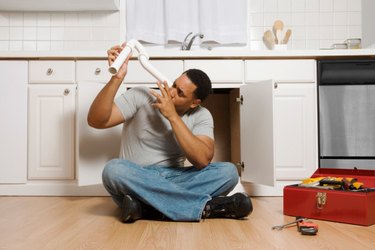
Homeowners are often surprised to find mold growing under their kitchen or bathroom sink. However, mold growth in these areas is a common occurrence. An abundance of moisture and mold spores work together to initiate mold growth. If you can see or smell mold underneath your sink, you must remove it to avoid unwanted health effects from mold exposure.
Identification
Video of the Day
Mold growth begins when mold spores find their way into our homes through open windows or doors. When mold spores land on an area of excess moisture and high humidity, they begin to grow. Certain rooms in our homes are more susceptible to mold growth than others. Bathrooms, kitchens and basements are susceptible to mold growth. Mold may also grow in laundry rooms and on carpet. To grow and thrive, mold spores must have moisture and humidity.
Video of the Day
Effects
Mold is often found underneath sinks in bathrooms and kitchens, where it is usually caused by leaking pipes. Cooking causes high humidity in kitchens, which is more severe if no ventilation fans are installed and running. Drywall located near leaky sink pipes often becomes covered with black, green or gray mold. If the source of the leak is inside a wooden cabinet, the wood may also become covered in mold.
Solution
If you smell or see mold underneath your kitchen or bathroom sink, you must clean it up. Scrub the area with a soft brush and a mixture of liquid dish detergent and water. After all mold is removed, dry the area with a cloth. After you have removed the mold, you must fix the source of moisture in the area. If you have leaky pipes that are not repaired, mold will soon return.
Prevention
While there is no way to remove mold spores from entering our environment, you can take steps to prevent mold growth. Controlling moisture is a key element in preventing mold growth. Repair all leaky pipes and reduce condensation in your home by adding insulation. Don't install carpet in areas prone to water leaks such as the basement and bathroom. Reducing indoor humidity is another way to prevent mold growth in your home. Install ventilation fans in your kitchen and bathroom and vent them to the outside. Run exhaust fans when cooking or showering. Keeping your shower temperature cooler will help reduce humidity in your bathroom.